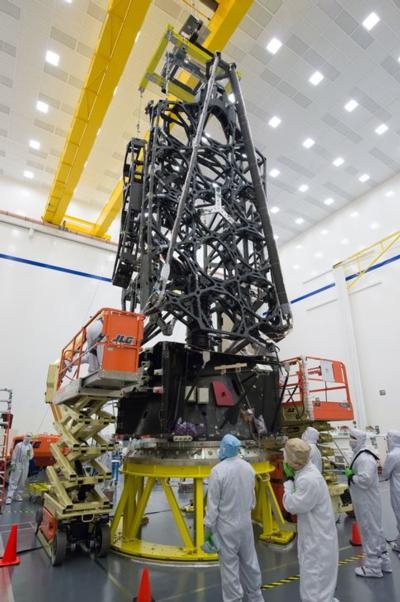Sun, Sep 06, 2015
Integration Of 18 Hexagonal Mirrors Can Now Commence
The telescope structure for NASA's James Webb Space Telescope was delivered Aug. 24 to Goddard Space Flight Center in Greenbelt, Maryland, paving the way for the integration of the 18 hexagonal mirrors that will help scientists observe the formation of the first stars and galaxies over 13.5 billion years ago.

Northrop Grumman is under contract to NASA's Goddard Space Flight Center and leads the industry team that designs and develops the Webb Telescope, its sunshield and spacecraft. Northrop Grumman has completed the integration and testing of the telescope structure, which holds optical assemblies of the telescope including its instruments and mirrors.
"The telescope's beryllium mirrors are held together nearly motionlessly in space by the telescope structure, which also acts as a stable platform during ground test operations and launch," said Scott Texter, telescope manager, Northrop Grumman Aerospace Systems. "The stability of this hardware contributes to the Webb Telescope's ability to provide an unprecedented look at our own solar system as well as discover exoplanets well beyond this solar system."
The highly efficient telescope structure will also meet first-time thermal stability requirements to minimize thermal distortion. While the telescope is operating at a range of extremely cold temperatures as low as 389 degrees below Fahrenheit, the backplane portion of the telescope structure must not vary more than 38 nanometers (approximately a thousandth the diameter of a human hair). Additionally, the breakthrough folding design of the transformer-like telescope structure enables it to fit inside the 15-foot-diameter fairing of the launch vehicle.
The Webb Telescope's secondary mirror support structure and deployable tower assembly (DTA) also contribute to how the telescope and instruments fit into the rocket fairing in preparation for launch. The graphite DTA was designed, built and tested by Astro Aerospace, a Northrop Grumman company. Additionally, the DTA is responsible for lifting the telescope mirrors and instruments away from the heat of the main spacecraft after deployment.
Completing and delivering the structure to NASA marks an important milestone in the journey of the Webb Telescope, which is the world's next-generation space observatory and successor to the Hubble Space Telescope.
(Image provided by Northrop Grumman)
More News
With Testing Soon Complete, Launch Preparations Begin in Earnest Sierra Space's Dream Chaser has been put through the wringer at NASA's Glenn Armstrong Test Facility in Ohio, but w>[...]
Takeoff Roll The process whereby an aircraft is aligned with the runway centerline and the aircraft is moving with the intent to take off. For helicopters, this pertains to the act>[...]
“We’re proud of the hard work that went into receiving this validation, and it will be a welcome relief to our customers in the European Union. We couldn’t be mor>[...]
"Aircraft Spruce is pleased to announce the acquisition of the parts distribution operations of Wag-Aero. Wag-Aero was founded in the 1960’s by Dick and Bobbie Wagner in the >[...]
IDENT Feature The special feature in the Air Traffic Control Radar Beacon System (ATCRBS) equipment. It is used to immediately distinguish one displayed beacon target from other be>[...]
 Sierra Space Repositions Dream Chaser for First Mission
Sierra Space Repositions Dream Chaser for First Mission ANN's Daily Aero-Term (05.10.24): Takeoff Roll
ANN's Daily Aero-Term (05.10.24): Takeoff Roll Aero-News: Quote of the Day (05.10.24)
Aero-News: Quote of the Day (05.10.24) Aero-News: Quote of the Day (05.11.24)
Aero-News: Quote of the Day (05.11.24) ANN's Daily Aero-Term (05.11.24): IDENT Feature
ANN's Daily Aero-Term (05.11.24): IDENT Feature



